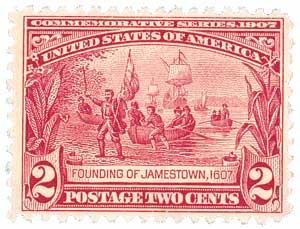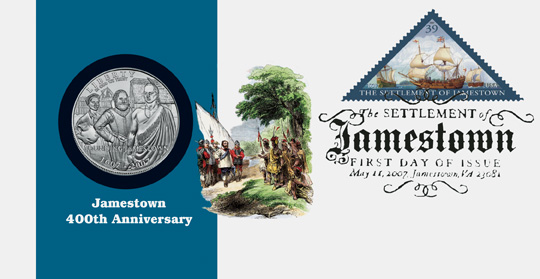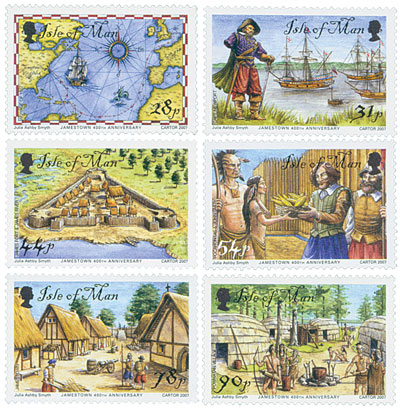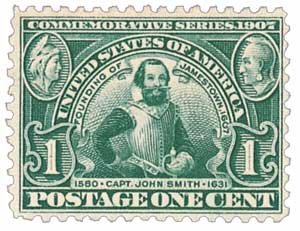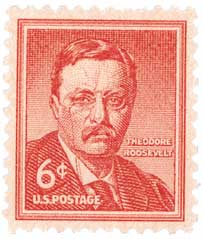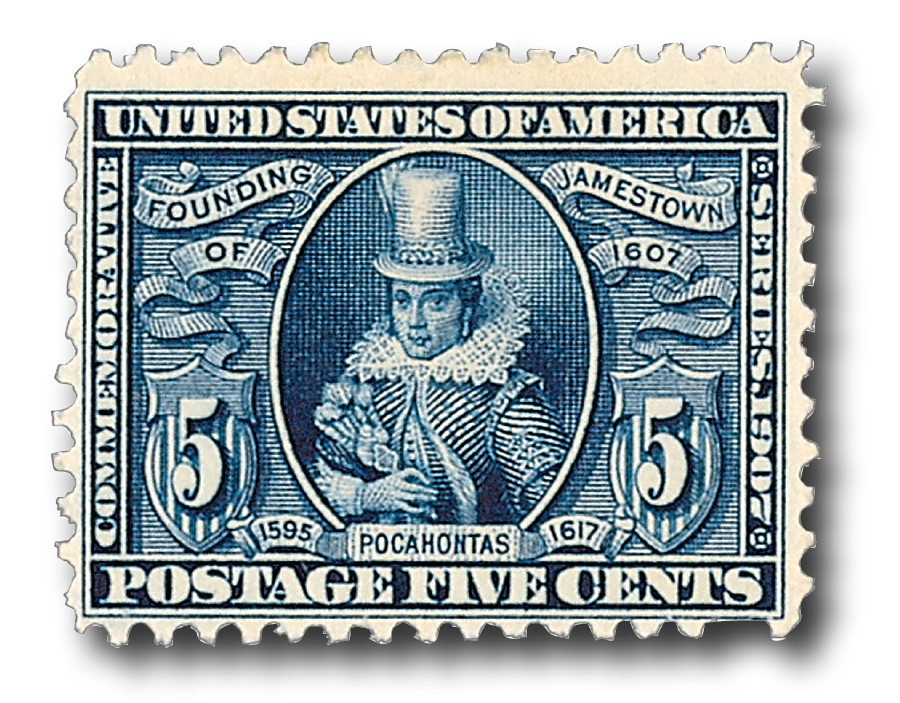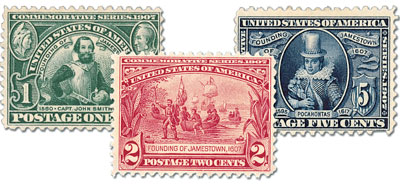
# 329 - 1907 2c Jamestown Commemorative: Founding of Jamestown
1907 2¢ Founding of Jamestown
Jamestown Commemorative
Quantity issued: 149,497,994
Printed by: Bureau of Engraving and Printing
Method: Flat plate
Watermark: Double line USPS
Perforation: 12
Color: Carmine
Jamestown Burns During Bacon’s Rebellion
On September 19, 1676, Nathaniel Bacon led an irate group of followers into Jamestown and burned nearly all the buildings to the ground.
In the mid-1670s, some Virginia colonists grew concerned over the government’s lack of action in the wake of increasing Native American attacks on their settlements. Among them was Nathaniel Bacon, who also took issue with Virginia’s governor William Berkeley. Bacon felt snubbed after not receiving a political appointment or being allow to trade with the Native Americans. When word spread about a new Indian raiding party, several hundred settlers met and elected Bacon as their leader, essentially beginning the rebellion.
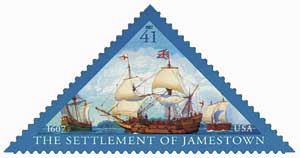
U.S. #4136 – Bacon’s rebellion and the burning of Jamestown are considered precursors to the American Revolution.
Though governor Berkeley warned against it, the rebels set out on a mission and destroyed much of the Susquehannock tribe. After returning to Jamestown, Bacon demanded a commission to lead a militia against the Native Americans. Berkeley initially refused, but after Bacon and his followers threatened the burgesses (elected representatives), they granted his commission.
Bacon and his army then drafted and issued the Declaration of the People of Virginia, criticizing Berkeley for unfair taxes, appointing friends to prominent positions, and failing to protect citizens from attacks. After attacking the friendly Pamunkey tribe, Bacon and his men moved toward Jamestown. Berkeley abandoned the town and avoided being captured. Bacon knew he couldn’t hold the capital city or let Berkeley take it back, so he decided to burn it to the ground. Bacon’s men ran between buildings with burning brands and torched homes, the statehouse, warehouses, taverns, and even the church. Berkeley and his loyalists who’d escaped watched the glow of their home burning from downstream.
With Jamestown destroyed, Bacon went back to attacking Native American tribes. However, about a month after the burning, he died suddenly from typhus and dysentery. Though a new leader rose to take Bacon’s place, the rebels slowly disbanded. Berkeley launched successful attacks to quiet any further uprising from Bacon’s followers. But he was later removed from his role as governor by King Charles II to consolidate power and prevent another rebellion.
Jamestown Exposition
On April 26, 1907, the Jamestown Exposition opened at Sewell’s Point in Norfolk, Virginia.
Jamestown was the first permanent English settlement in America and was founded on May 14, 1607. It was there that the first representative government of the American continent was established.
Plans for an exposition honoring the 300th anniversary of the settlement of Jamestown began as early 1900. Isolated and long-abandoned, the actual site of Jamestown wasn’t considered as a location for the fair. Rather, a debate raged between the capital city of Richmond and the largely populated Norfolk (about 100 miles away) as to who would host the fair.
In 1902 Virginia residents formed the Jamestown Exposition Co. with governor Fitzhugh Lee (nephew of Robert E. Lee) as its president. The company ultimately selected Sewall’s point as the site for the fair. The secluded location meant that new roads needed to be built and streetcar and railroad lines extended. Additionally, new piers were built on the shore and new hotels to house the millions of expected visitors.
The fair’s opening day was set for April 26, 1907, the 300th anniversary of the colonist’s landing on the southern shore of the Chesapeake Bay. However, bad weather had delayed construction, so only 14 of the 38 buildings were completed and only a fifth of the electric lights could be turned on.
The opening ceremonies included a speech by president Theodore Roosevelt (which you can read here). Roosevelt was a strong supporter of the exposition, signing a $3 million appropriation from Congress. He saw the expo as a way to show off America’s military might, particularly his Great White Fleet. On opening day he presided over a naval revue, which included 33 American ships, as well as a few ships from Germany, Austria-Hungary, Brazil, Chile, and Argentina. Roosevelt would return to the fair in June to dedicate the Georgia House, which had been based on his mother’s family home.
The exposition spanned 340-acres and included 21 “houses” honoring different states and their histories. Among the other exhibits was a model of the Panama Canal, a wild animal show, and a Wild West show. One of the most popular attractions was the re-creation of the Battle of Hampton Roads, the Civil War battle noted as the first between two ironclad warships.
A number of notable people attended the fair, including Booker T. Washington, William Jennings Bryan, Cornelius Vanderbilt, William Randolph Hearst, and Mark Twain. By the time the fair ended in December 1907, about 3 million people had attended. This was far below what planners had anticipated and the fair ended up losing millions of dollars.
Despite the fair’s financial failure, there was a silver lining. The fair showcased Sewall’s Point, which had been significant during the Civil War, but nearly forgotten in the years that followed. Soon naval admirals suggested that the fair site be redeveloped into a naval base. While no action was taken right away, the start World War I led to the area’s development and eventual conversion into Naval Station Norfolk. Today it’s the world’s largest naval station.
Jamestown Exposition Stamps
The exposition’s organizers asked the Post Office Department to design stamps to commemorate the exposition, as they had done since the 1893 World’s Columbian Exposition. While the postmaster general initially declined, President Theodore Roosevelt urged him to change his mind.
Plans for the stamps changed a few times. One idea was a set of 10 stamps commemorating several key people in the founding of Jamestown. Another plan was to create two stamps, (1¢ and 2¢) picturing the ruins of the Jamestown church and the arrival of the British ships. Learning that a number of foreign ships would be present for the exposition, postal officials realized that there should also be a 5¢ stamp to meet the foreign postage rate.
Ultimately, John Smith was selected for the 1¢, with a portrait based on an engraving by Crispin Van de Passe the younger. It includes medallions of Pocahontas and her father, Chief Powhatan, in the corners. The 2¢ stamp pictures the landing at Jamestown with a tobacco plant and stalk of corn on each side. The design shows colonists coming ashore with rowboats while their fleet is anchored in the distance. Finally, the 5¢ stamp features a portrait of Pocahontas based on a 1616 engraving by Simon Van de Passe.
The first two stamps were issued on the opening day of the exposition, while the third stamp was issued less than two weeks later. The Post Office Department opened a special branch at the exposition (called Exposition Station) where it applied a special cancel to all covers brought there until the end of the fair.
1907 2¢ Founding of Jamestown
Jamestown Commemorative
Quantity issued: 149,497,994
Printed by: Bureau of Engraving and Printing
Method: Flat plate
Watermark: Double line USPS
Perforation: 12
Color: Carmine
Jamestown Burns During Bacon’s Rebellion
On September 19, 1676, Nathaniel Bacon led an irate group of followers into Jamestown and burned nearly all the buildings to the ground.
In the mid-1670s, some Virginia colonists grew concerned over the government’s lack of action in the wake of increasing Native American attacks on their settlements. Among them was Nathaniel Bacon, who also took issue with Virginia’s governor William Berkeley. Bacon felt snubbed after not receiving a political appointment or being allow to trade with the Native Americans. When word spread about a new Indian raiding party, several hundred settlers met and elected Bacon as their leader, essentially beginning the rebellion.

U.S. #4136 – Bacon’s rebellion and the burning of Jamestown are considered precursors to the American Revolution.
Though governor Berkeley warned against it, the rebels set out on a mission and destroyed much of the Susquehannock tribe. After returning to Jamestown, Bacon demanded a commission to lead a militia against the Native Americans. Berkeley initially refused, but after Bacon and his followers threatened the burgesses (elected representatives), they granted his commission.
Bacon and his army then drafted and issued the Declaration of the People of Virginia, criticizing Berkeley for unfair taxes, appointing friends to prominent positions, and failing to protect citizens from attacks. After attacking the friendly Pamunkey tribe, Bacon and his men moved toward Jamestown. Berkeley abandoned the town and avoided being captured. Bacon knew he couldn’t hold the capital city or let Berkeley take it back, so he decided to burn it to the ground. Bacon’s men ran between buildings with burning brands and torched homes, the statehouse, warehouses, taverns, and even the church. Berkeley and his loyalists who’d escaped watched the glow of their home burning from downstream.
With Jamestown destroyed, Bacon went back to attacking Native American tribes. However, about a month after the burning, he died suddenly from typhus and dysentery. Though a new leader rose to take Bacon’s place, the rebels slowly disbanded. Berkeley launched successful attacks to quiet any further uprising from Bacon’s followers. But he was later removed from his role as governor by King Charles II to consolidate power and prevent another rebellion.
Jamestown Exposition
On April 26, 1907, the Jamestown Exposition opened at Sewell’s Point in Norfolk, Virginia.
Jamestown was the first permanent English settlement in America and was founded on May 14, 1607. It was there that the first representative government of the American continent was established.
Plans for an exposition honoring the 300th anniversary of the settlement of Jamestown began as early 1900. Isolated and long-abandoned, the actual site of Jamestown wasn’t considered as a location for the fair. Rather, a debate raged between the capital city of Richmond and the largely populated Norfolk (about 100 miles away) as to who would host the fair.
In 1902 Virginia residents formed the Jamestown Exposition Co. with governor Fitzhugh Lee (nephew of Robert E. Lee) as its president. The company ultimately selected Sewall’s point as the site for the fair. The secluded location meant that new roads needed to be built and streetcar and railroad lines extended. Additionally, new piers were built on the shore and new hotels to house the millions of expected visitors.
The fair’s opening day was set for April 26, 1907, the 300th anniversary of the colonist’s landing on the southern shore of the Chesapeake Bay. However, bad weather had delayed construction, so only 14 of the 38 buildings were completed and only a fifth of the electric lights could be turned on.
The opening ceremonies included a speech by president Theodore Roosevelt (which you can read here). Roosevelt was a strong supporter of the exposition, signing a $3 million appropriation from Congress. He saw the expo as a way to show off America’s military might, particularly his Great White Fleet. On opening day he presided over a naval revue, which included 33 American ships, as well as a few ships from Germany, Austria-Hungary, Brazil, Chile, and Argentina. Roosevelt would return to the fair in June to dedicate the Georgia House, which had been based on his mother’s family home.
The exposition spanned 340-acres and included 21 “houses” honoring different states and their histories. Among the other exhibits was a model of the Panama Canal, a wild animal show, and a Wild West show. One of the most popular attractions was the re-creation of the Battle of Hampton Roads, the Civil War battle noted as the first between two ironclad warships.
A number of notable people attended the fair, including Booker T. Washington, William Jennings Bryan, Cornelius Vanderbilt, William Randolph Hearst, and Mark Twain. By the time the fair ended in December 1907, about 3 million people had attended. This was far below what planners had anticipated and the fair ended up losing millions of dollars.
Despite the fair’s financial failure, there was a silver lining. The fair showcased Sewall’s Point, which had been significant during the Civil War, but nearly forgotten in the years that followed. Soon naval admirals suggested that the fair site be redeveloped into a naval base. While no action was taken right away, the start World War I led to the area’s development and eventual conversion into Naval Station Norfolk. Today it’s the world’s largest naval station.
Jamestown Exposition Stamps
The exposition’s organizers asked the Post Office Department to design stamps to commemorate the exposition, as they had done since the 1893 World’s Columbian Exposition. While the postmaster general initially declined, President Theodore Roosevelt urged him to change his mind.
Plans for the stamps changed a few times. One idea was a set of 10 stamps commemorating several key people in the founding of Jamestown. Another plan was to create two stamps, (1¢ and 2¢) picturing the ruins of the Jamestown church and the arrival of the British ships. Learning that a number of foreign ships would be present for the exposition, postal officials realized that there should also be a 5¢ stamp to meet the foreign postage rate.
Ultimately, John Smith was selected for the 1¢, with a portrait based on an engraving by Crispin Van de Passe the younger. It includes medallions of Pocahontas and her father, Chief Powhatan, in the corners. The 2¢ stamp pictures the landing at Jamestown with a tobacco plant and stalk of corn on each side. The design shows colonists coming ashore with rowboats while their fleet is anchored in the distance. Finally, the 5¢ stamp features a portrait of Pocahontas based on a 1616 engraving by Simon Van de Passe.
The first two stamps were issued on the opening day of the exposition, while the third stamp was issued less than two weeks later. The Post Office Department opened a special branch at the exposition (called Exposition Station) where it applied a special cancel to all covers brought there until the end of the fair.












